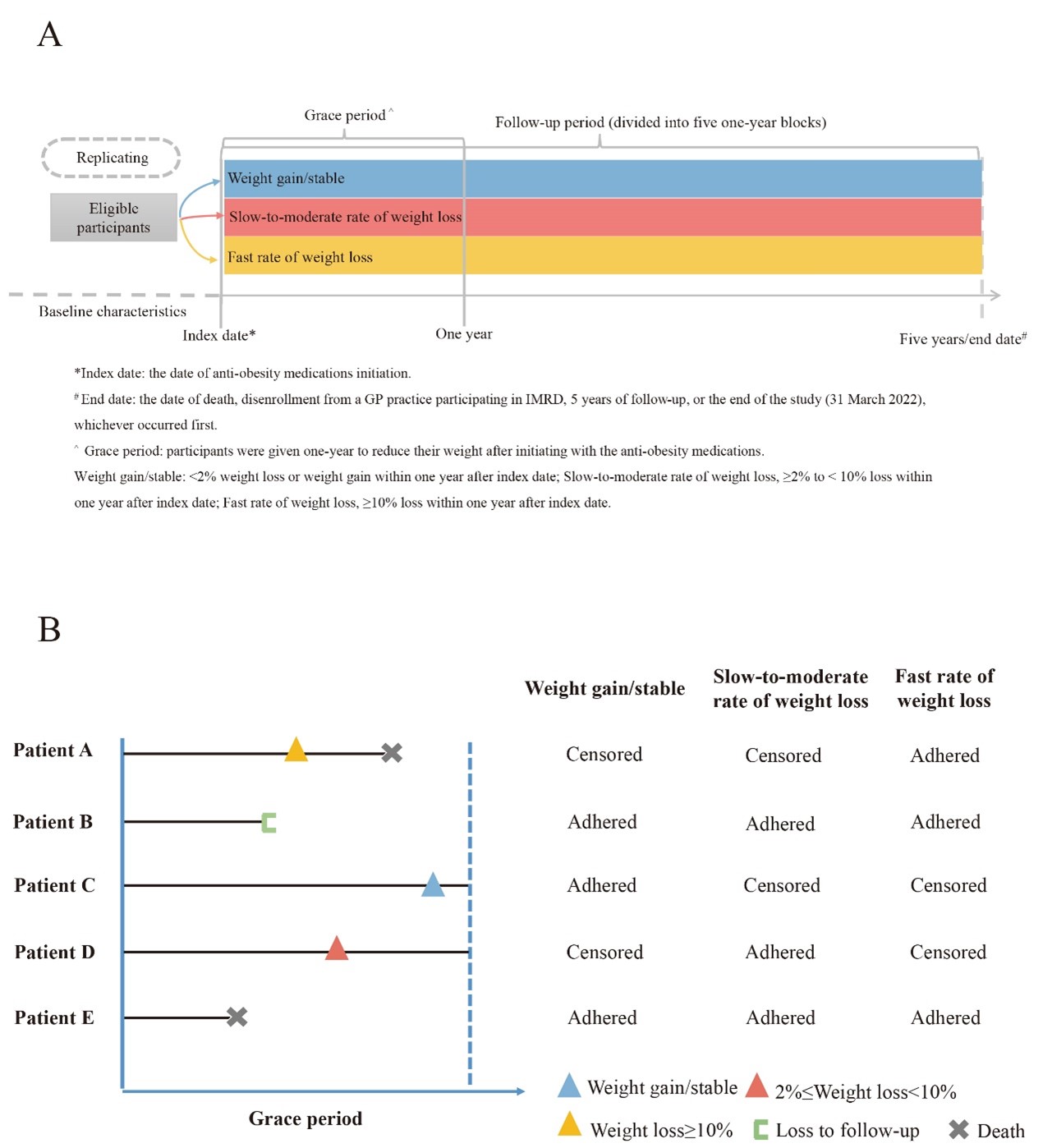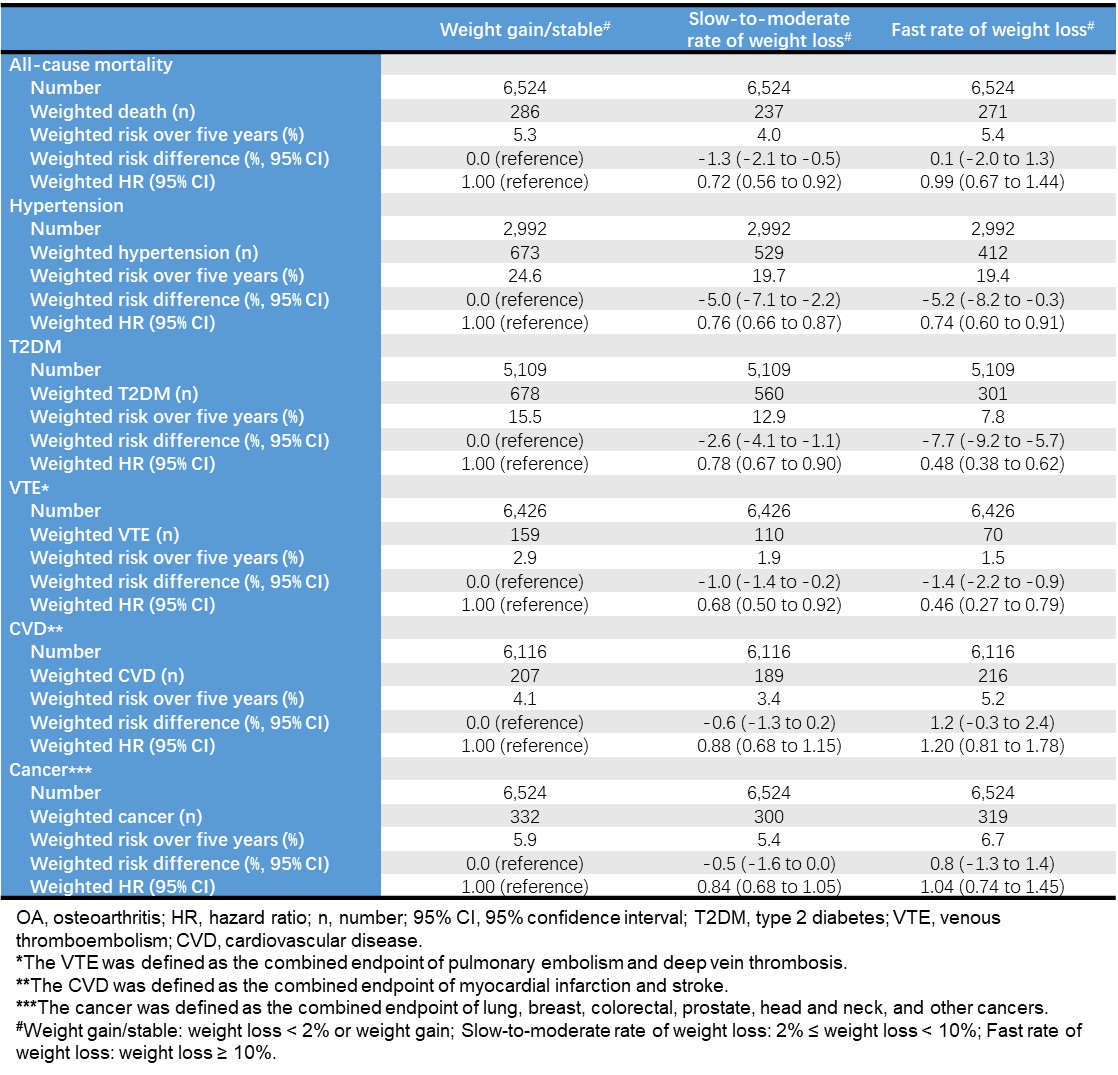Poster Session C
Osteoarthritis (OA) and related disorders
Session: (1977–1995) Osteoarthritis – Clinical Poster III
1979: Weight Loss Induced by Anti-obesity Medications and All-cause Mortality Among Patients with Knee or Hip Osteoarthritis
Tuesday, November 14, 2023
9:00 AM - 11:00 AM PT
Location: Poster Hall
- JW
Jie Wei, PhD (she/her/hers)
Health Management Center, Xiangya Hospital Central South University
Changsha, ChinaDisclosure information not submitted.
Abstract Poster Presenter(s)
Jie Wei1, david Hunter2, Nancy Lane3, Jing Wu4, Chao Zeng5, Guanghua Lei5 and Yuqing Zhang6, 1Health Management Center, Xiangya Hospital Central South University, Changsha, China, 2Sydney Musculoskeletal Health, University of Sydney, St. Leonards, Australia, 3University of California, Hillsborough, CA, 4Key Laboratory of Aging-related Bone and Joint Diseases Prevention and Treatment, Ministry of Education, Xiangya Hospital, Central South University, Changsha, China, 5Department of Orthopaedics, Xiangya Hospital, Central South University, Changsha, China, 6Division of Rheumatology, Allergy, and Immunology, Department of Medicine, Massachusetts General Hospital, Boston, MA
Background/Purpose: The current international guidelines recommend weight loss for pain relief and functional improvement in overweight or obese patients with knee or hip osteoarthritis; however, there is a paucity of data on the relation of weight loss to all-cause mortality among patients with osteoarthritis. We aimed to examine the relation of the rate of weight loss induced by anti-obesity medications over 1-year to all-cause mortality among overweight/obese patients with knee or hip osteoarthritis.
Methods: Using IQVIA Medical Research Database in the United Kingdom, we identified overweight/obese people aged 40 years or older with knee or hip osteoarthritis. We emulated analyses of a hypothetical target trial using a "cloning, censoring, and weighting" approach to assess the effect of slow-to-moderate (2-10%) or fast (≥10%) weight loss induced by the initiation of anti-obesity medications (i.e., orlistat, sibutramine, and rimonabant) within 1-year on all-cause mortality and several secondary outcomes (i.e., incident hypertension, type 2 diabetes, venous thromboembolism, cardiovascular disease, and any cancer) over 5-year follow-up, respectively (Figure 1).
Results: Among 6,524 participants initiating anti-obesity medications, the 5-year all-cause mortality was 5.3%, 4.0%, and 5.4% for "weight gain/stable", "slow-to-moderate weight loss" and "fast weight loss" arms, respectively. Compared with the "weight gain/stable" arm, hazard ratios (HRs) of all-cause mortality were 0.72 (95% confidence interval [CI]: 0.56-0.92) for the "slow-to-moderate weight loss" arm and 0.99 (95%CI: 0.67-1.44) for the "fast weight loss" arm, respectively. In addition, we found dose-response protective effects of weight loss on incident hypertension, type 2 diabetes, and venous thromboembolism. However, a slightly higher risk of cardiovascular disease, albeit non-statistically significant, was observed in the "fast rate of weight loss" arm compared with the "weight gain/stable" arm (HR=1.20, 95%CI: 0.81-1.78). No apparent difference in the risk of cancer was observed between the "fast rate of weight loss" arm and the "weight gain/stable" arm (HR=1.04, 95%CI: 0.74-1.45) (Table 1).
Conclusion: In this population-based study, a slow-to-moderate, but not fast, rate of weight loss induced by anti-obesity medications within 1-year is associated with a lower risk of all-cause mortality in overweight/obese people with knee or hip osteoarthritis. Our findings that gradual weight loss by anti-obesity medications lower all-cause mortality, if confirmed by future studies, could guide policy-making, and improve the well-being of overweight/obese patients with knee or hip OA.


J. Wei: None; d. Hunter: None; N. Lane: None; J. Wu: None; C. Zeng: None; G. Lei: None; Y. Zhang: None.
Background/Purpose: The current international guidelines recommend weight loss for pain relief and functional improvement in overweight or obese patients with knee or hip osteoarthritis; however, there is a paucity of data on the relation of weight loss to all-cause mortality among patients with osteoarthritis. We aimed to examine the relation of the rate of weight loss induced by anti-obesity medications over 1-year to all-cause mortality among overweight/obese patients with knee or hip osteoarthritis.
Methods: Using IQVIA Medical Research Database in the United Kingdom, we identified overweight/obese people aged 40 years or older with knee or hip osteoarthritis. We emulated analyses of a hypothetical target trial using a "cloning, censoring, and weighting" approach to assess the effect of slow-to-moderate (2-10%) or fast (≥10%) weight loss induced by the initiation of anti-obesity medications (i.e., orlistat, sibutramine, and rimonabant) within 1-year on all-cause mortality and several secondary outcomes (i.e., incident hypertension, type 2 diabetes, venous thromboembolism, cardiovascular disease, and any cancer) over 5-year follow-up, respectively (Figure 1).
Results: Among 6,524 participants initiating anti-obesity medications, the 5-year all-cause mortality was 5.3%, 4.0%, and 5.4% for "weight gain/stable", "slow-to-moderate weight loss" and "fast weight loss" arms, respectively. Compared with the "weight gain/stable" arm, hazard ratios (HRs) of all-cause mortality were 0.72 (95% confidence interval [CI]: 0.56-0.92) for the "slow-to-moderate weight loss" arm and 0.99 (95%CI: 0.67-1.44) for the "fast weight loss" arm, respectively. In addition, we found dose-response protective effects of weight loss on incident hypertension, type 2 diabetes, and venous thromboembolism. However, a slightly higher risk of cardiovascular disease, albeit non-statistically significant, was observed in the "fast rate of weight loss" arm compared with the "weight gain/stable" arm (HR=1.20, 95%CI: 0.81-1.78). No apparent difference in the risk of cancer was observed between the "fast rate of weight loss" arm and the "weight gain/stable" arm (HR=1.04, 95%CI: 0.74-1.45) (Table 1).
Conclusion: In this population-based study, a slow-to-moderate, but not fast, rate of weight loss induced by anti-obesity medications within 1-year is associated with a lower risk of all-cause mortality in overweight/obese people with knee or hip osteoarthritis. Our findings that gradual weight loss by anti-obesity medications lower all-cause mortality, if confirmed by future studies, could guide policy-making, and improve the well-being of overweight/obese patients with knee or hip OA.

Figure 1. Study design of a hypothetical randomized controlled trial (“target trial”) on which we modeled our observational data analysis (A); Cloning and censoring in five hypothetical patients (B). Patient A lost ≥ 10% weight within one year after anti-obesity medications initiation. At time zero, 3 copies of the patient are made and they are randomly allocated to three groups. Patient A lost ≥ 10% weight within one year after anti-obesity medications initiation. The copy assigned to the “fast rate of weight loss” group is adhered with his/her assignment and will not be censored. However, the other two copies assigned to the “weight gain/stable” group and “slow-to-moderate rate of weight loss” group are violated with their assignment, and thus be censored at the time.

Table 1. Relations of weight reduction induced by anti-obesity medications within 1-year to all-cause mortality, incident hypertension, T2DM, VTE, CVD and cancer in overweight or obese knee or hip OA patients
J. Wei: None; d. Hunter: None; N. Lane: None; J. Wu: None; C. Zeng: None; G. Lei: None; Y. Zhang: None.



